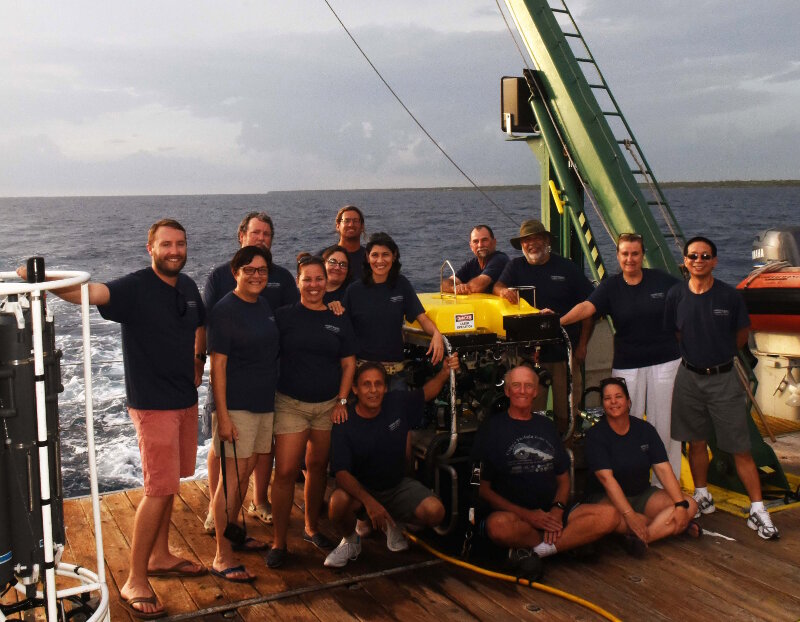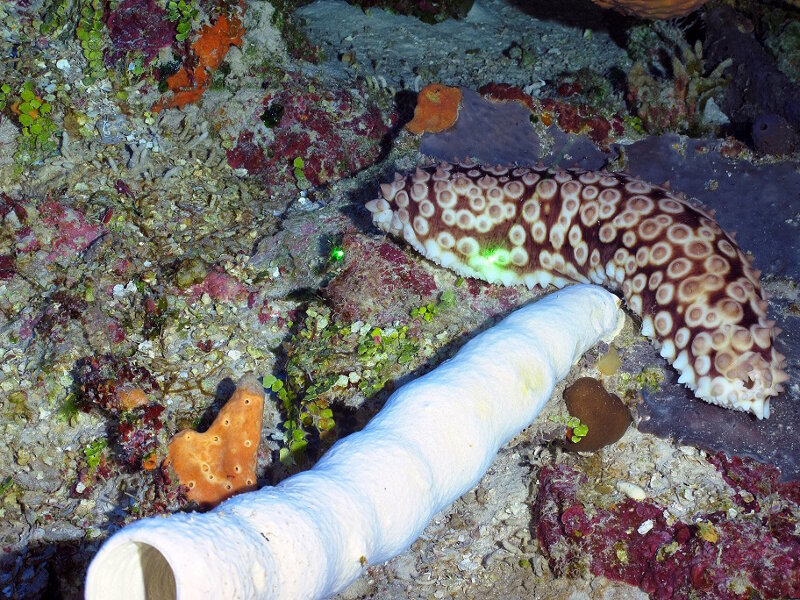
By Leg 1 Participants - Cuba’s Twilight Zone Reefs Expedition
May 29, 2017
Video highlights from Leg 1 dives using the Mohawk ROV. Video courtesy of Cuba’s Twilight Zone Reefs and Their Regional Connectivity. Download (mp4, 119.3 MB).
Yesterday we finished the first leg of the Cuba’s Twilight Zone Reefs expedition, with a golden experience. The last dive with the Mohawk remotely operated vehicle (ROV) was in Bay of Pigs, specifically Punta Perdiz. The dive started at 150 meters of depth, despite the ship being barely 100 meters from the shore. The bottom, a desert of sand and rock, had a steep slope of 90 degrees. This bare lunar seascape could not prepare us for what we found in the shallower areas of the reef.

Group photo of Leg 1 scientific party. Image courtesy of Cuba’s Twilight Zone Reefs and Their Regional Connectivity. Download larger version (jpg, 1.5 MB).
At a depth of 106 meters, we discovered a depth record for a species of the scleractinean coral Solenatrea, which was followed by large plates of Agaricia and Montastrea. In the upper mesophotic reef, the coverage of scleractinean corals reached at least 80 percent, a live cover that most of us have not seen in the Caribbean since the 1970s. There were large clumps of Porites porites, Orbicella complex, Montastrea cavernosa, and Colpophillya natans. Algae and sponges definitively were outnumbered by live corals on the open reef. The large coral plates, however, offer cryptic or sciophilous (thriving in shade) habitats that remain to be explored.

High density of plate corals in the upper mesophotic reef. Image courtesy of Cuba’s Twilight Zone Reefs and Their Regional Connectivity. Download larger version (jpg, 666 KB).
Several new species of sponges were observed. One was “Ircina campana gorda,” probably a sister species of Ircina campana, that had consistent morphological differences throughout its depth range of ocurrence. Another was an extremely smooth Geoiidae, which was snow white at its deepest range >100 meters and became darker as we moved shallower. At the end of the dive (30-40 meters), a bright red, thin-branching, humongous sponge appeared. We were able to collect it after setting the ROV on the bottom. Once on the ship, Linnet Busutil and Cristina Diaz studied the skeleton to find out that it probably is an undescribed species of Clathria, a sponge that we only have encountered in Bahia de Cochinos.

A white sponge (Aplysina sp.) and a polka dot sea cucumber. Image courtesy of Cuba’s Twilight Zone Reefs and Their Regional Connectivity. Download larger version (jpg, 358 KB).
Let’s not forget the fish. The fish observations increased as depth decreased, with a peak of diversity between 30-60 meters of depth. The main species observed belonged to the Chaetodontidae, Pomacanthidae, Acanthuridae, and Scaridae families. The high relative abundance of herbivory probably contributes to keeping the algae under control and contributes to the health of the reef. Specifically, the hamlet species Hypoplectrus vaquitas was very abundant.
Seaweeds were limited by the live coral coverage and by the rain of sand that continuously falls from shallower water. In the deepest mesophotic zone at 140 meters, Beatriz Martínez started recording red coralline algae, together with an unknown green crust. All these species together with the live coral cover and diversity makes this site especially attractive.